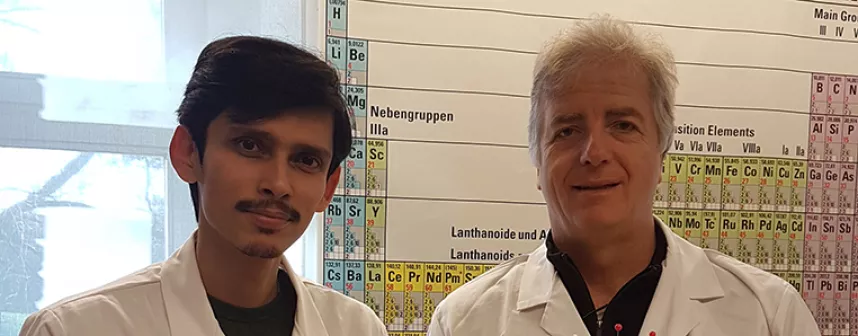Researchers at Jacobs University Bremen discover a new class of heterogeneous catalysts based on precious metals
February 20, 2019
It is stable and recyclable: a team of scientists from Jacobs University led by Ulrich Kortz, Professor of Chemistry, has developed a new class of materials in close cooperation with researchers from the Carl von Ossietzky University of Oldenburg and the Technical University of Munich. The compound based on the precious metal palladium paves the way for the full use of the entire class of discrete polyoxopalladates (POPs) as building blocks for 3D framework materials (MOFs). The project was funded by the German Research Foundation (DFG). The name of the new class of materials: POP-MOF, JUB-1.
Precious metals such as palladium are probably the most omnipresent catalysts in modern organic synthetic chemistry. In 2010, the Nobel Prize in Chemistry was awarded for such research work (Heck, Negishi, Suzuki). Reactions involving palladium-based catalysts are important tools in various processes of industrial importance, such as the synthesis of agrochemicals, natural products, pharmaceuticals, and high octane gasoline. The reason for such a wide-ranging scope boils down to the unique ability of palladium (either in +2 or 0 oxidation states) to act as an efficient catalyst in various organic reactions. However, the efficacy of such catalytic reactions can be hampered severely by several factors such as (i) instability of the catalyst due to leaching or (ii) poor recyclability and hence recovery of the catalyst. Thus, over the past few decades, researchers from around the world have been working intensely on the development of novel, improved Pd-based catalytic materials.
In 2008 the research group of Ulrich Kortz, who is an expert in the synthesis of polynuclear metal-oxide clusters (so called polyoxometalates or POMs), made a pivotal discovery with the synthesis of the first discrete noble metal-based POM in aqueous medium. This polyoxopalladate (or POP) with the formula [Pd13O8(AsO4)8H6]8- paved the way for a large family (currently ca. 70) of POPs of various size, shape and composition. Catalytic studies using the highly active POPs helps to better understand the mechanism of noble metal-based molecular catalysis. However, it is difficult to recover soluble (homogeneous) catalysts from the reaction products and hence the chemical industry usually prefers insoluble (heterogeneous) catalysts with a large surface area.
, Ulrich Kortz, Professor of Chemistry at Jacobs University in Bremen, and his coworker Dr. Saurav Bhattacharya with a POM model. (Source: private)In this context, Prof. Kortz and his co-workers Dr. Saurav Bhattacharya and Dr. Wassim W. Ayass envisaged a strategy wherein they could use externally modified discrete POPs as building blocks for the construction of a rigid and catalytically active framework material, a so-called metal-organic framework (MOF). MOFs are an important class of materials comprising ordered periodic networks of molecular components (metal ions or clusters) that are interconnected in three dimensions by organic groups (linkers), leading to a stable framework structure with accessible cavities or pores. This can be compared to the construction of a traditional timber-framed German house, where the wooden pegs (metal ions or clusters) are held in place by beams (rigid organic linkers) and the resulting rooms would be analogous to the pores of the MOF.
Utilizing this strategy, Saurav Bhattacharya has now constructed such a molecular house by synthesizing a stable POP-based MOF material (POP-MOF) for the first time. Wassim Ayass assisted him in evaluating its heterogeneous catalytic activity for microwave-assisted Suzuki-Miyaura C-C coupling reactions. The team discovered that the catalyst has good stability and recyclability. The name of the new material (JUB-1) is derived from the location of the invention, Jacobs University Bremen (JUB). Another research team at JUB (Prof. V. Wagner, Physics) as well as research teams of the Carl von Ossietzky University Oldenburg and the Technical University Munich were also involved in the physicochemical characterization of JUB-1.
The results of the research work have now been published in the renowned Journal of the American Chemical Society.
, The new class of materials: POP-MOF, JUB-1. (Source: Dr. Rami Al-Oweini)Discovery of Polyoxo-Noble-Metalate-Based Metal-Organic Frameworks
Bhattacharya, S.; Ayass, W. W.; Taffa, D. H.; Schneemann, A.; Semrau, A. L.; Wannapaiboon, S.; Altmann, P. J.; Pöthig, A.; Nisar, T.; Balster, T.; Burtch, N. C.; Wagner, V.; Fischer, R. A.; Wark, M.; Kortz, U.
J. Am. Chem. Soc. 2019, DOI: 10.1021/jacs.8b13397 [https://pubs.acs.org/doi/10.1021/jacs.8b13397]
Further questions can be addressed to:
Ulrich Kortz | professor of chemistry
u.kortz [at] jacobs-university.de | Tel.: +49 421 200-3235
